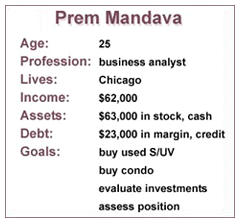|
Analyst is on right road
|
 |
October 16, 2000: 2:32 p.m. ET
A business analyst in Chicago wants to know how he shapes up
By Staff Writer Alex Frew McMillan
|
NEW YORK (CNNfn) - Prem Mandava learned the value of a rupee growing up in Hyderbad, India. Now he wants some advice on his dollars.
"My dad was a civil contractor, and as a result I got a first-hand look at financial pressures," Mandava said. "Some months, we would have a huge surplus of money, and some months we would be scraping together money because the payments by the Department of Waterworks weren't on time."
 Mandava, 25, learned to plan. He also got hooked on the market. He and three friends at the University of Hyderbad tripled their money investing in Indian stocks. Mandava, 25, learned to plan. He also got hooked on the market. He and three friends at the University of Hyderbad tripled their money investing in Indian stocks.
He lost track when he moved to the United States. But Mandava is back in the saddle.
He has $15,000 in borrowed money, or margin, from E*Trade, puts $250 a week into his account, pays $250 a month into a Pfizer (PFE: Research, Estimates) dividend reinvestment program and contributes $480 a month to his 401(k).
He has $50,000 in six or so tech stocks, the area he says he knows best. He owes $8,000 on credit cards but still has a net worth of $40,000, he figures. He wants to know if his strategy makes sense.
Looking for something that fits
Mandava moved to the United States in 1996. He got a bioengineering master's at the University of Illinois at Urbana-Champaign, which gave him a full scholarship.
But bioengineering companies were too small to help with a work visa. So Mandava went to work in information technology, which he'd studied on the side.
 He makes $62,000 as a business analyst with American Management Systems (AMSY: Research, Estimates). The company got him an H1-B professional work visa. Mandava finds out what the computing consultant's clients want and explains how its code programmers might do it. He makes $62,000 as a business analyst with American Management Systems (AMSY: Research, Estimates). The company got him an H1-B professional work visa. Mandava finds out what the computing consultant's clients want and explains how its code programmers might do it.
Mandava lives in Chicago, in an Oak Park apartment. He's been using public transportation. But he wants to buy a sport/utility vehicle.
Checks & Balances runs weekly. People with questions about financial planning are invited to write in explaining their financial goals. See the bottom of this article for specifics.
"I'm 6' 4" and don't fit too well into smaller cars," he explained. He figures he'll buy a three- to five-year old S/UV coming off lease, maybe a Mercedes M-Class. That might be in his $20,000 to $25,000 price range.
Searching for the right place
He also wants to buy a condo. Mandava is mulling a return to his homeland -- he helped a couple of his buddies with business plans.
 "So I always have that option." But he'd rent his condo out, he says, and let a management company monitor it. "I want to at least have the place for five years." "So I always have that option." But he'd rent his condo out, he says, and let a management company monitor it. "I want to at least have the place for five years."
Chicago's South Slope area is up-and-coming, Mandava reckons. "They're developing it now, and it'll take a year to clean up, and that's about the time I'd be ready."
He has been looking at two-bedroom condos in the $170,000 to $250,000 range. Mandava wants to put down 20 percent to avoid paying private mortgage insurance.
"Overall, I would like to know how I compare with other people in my age group," he said. Where can he improve?
What the planners say:
People like to compare themselves with others, notes Barbara Steinmetz, a certified financial planner in Burlingame, Calif. But "individuals have different goals and different backgrounds that influence their attitudes toward money."
Mandava has gotten a good start, she and Diane Rolfsmeyer concur. People his age usually have a negative net worth, Rolfsmeyer, a certified financial planner in Lincoln, Neb., noted. So to have any -- let alone Mandava's $40,000 -- "is exemplary."
He is planning early, has no student debt and is actively investing. But he needs to refine his approach, Steinmetz said.
Ditch the debt
First off, Mandava should set aside three to nine months of living expenses, she believes. He should keep the money liquid, in an emergency account that pays good interest and has check-writing privileges.
The Vanguard Prime Portfolio Money Market fund and the Strong Advantage fund (STADX), a very-short-term bond fund, are "excellent vehicles," Steinmetz said. Both have high limits on the minimum dollar size for checks, and other requirements to consider.
Next, Mandava needs to shed his credit card debt, Steinmetz said. It will affect his borrowing power when he buys a condo. What's more, credit card debt isn't tax deductible.
"You should make a commitment to pay down as much as you can as rapidly as you can," she said. Considering the poor stock market over the last six months, paying off his credit card debt would have been better than investing, Steinmetz noted.
On the margin, it's an idea to reconsider
Mandava ought to rethink his investments, Steinmetz said. Margin probably served him well when the market was skyrocketing. But his portfolio is down at least 12 percent this year.
Rolfsmeyer suggests he calculate the return on his margin stock against the cost of the debt. In this flat market, she figures he's in the hole. "The higher return might well be in reducing this debt as quickly as prudent," she said.
Mandava wants to use stock for a downpayment on his condo. It's not wise to invest in stock with a timeline of less than five years, Steinmetz said.
"It is really a gamble when you are using a margin account for a short-term goal such as your downpayment," she said.
Instead, Mandava should set aside in his emergency account, the planner thinks. With U.S. markets near their lows for the year, it's clear how a pullback could jeopardize his home buying if he has to sell stock, she said.
Planning for the condo
In his price range, Mandava will need $30,000 to $50,000, plus closing costs of roughly $7,500, Steinmetz figures. That's if he's paying down 20 percent.
So he will borrow $140,000 to $200,000. Assuming he takes a 30-year mortgage at 7.75 percent, his payments will be $1,000 to $1,400 a month, Steinmetz calculates.
Rolfsmeyer suggests buying a home that's an investment. Looking in an up-and-coming area is a start.
But condos don't hold their resale value as well as houses, Rolfsmeyer said. Mandava might qualify for first-time buyer and neighborhood-rehabilitation grants if he fixes up an older house, she said. He would likely have to stay in it for a set period.
Click this link to read last week's Checks & Balances column.
Click the following link to read last week's Portfolio Rx, a column that runs every Tuesday in CNNfn's Retirement section. Each article reviews an investor's long-term portfolio, using financial experts to offer advice.
Steinmetz suggests he start saving the difference between his $500 rent and his future payment -- at least $500 a month.
He will be saving. But he will also get used to making larger monthly payments. She recommends talking to a mortgage broker who could pre-qualify him for a loan.
Mandava pays $480 a month into his 401(k). That's just over 9 percent of his salary.
Steinmetz points out he could pay in as much as 15 percent, or $775 a month. The extra payments would save him $980 in federal tax this year, plus on his state taxes, she says.
Too heavy into techs
Mandava has not set up a Roth IRA. He is waiting until April 2001.
Steinmetz says it's best to make Roth payments as soon after Jan. 1 as possible. He'd have had 16 months of tax-deferred growth over his current plan. He should ramp up his 401(k) payments first though, she believes.
Mandava is not sufficiently diversified, both planners agree. His attitude that he understands technology best is very common for his age, Steinmetz said.
But two stocks -- Commerce One (CMRC: Research, Estimates) and Satyam Infoway (SIFY: Research, Estimates) -- account for almost half his brokerage portfolio.
"This type of concentration means you have to be an excellent stock picker, something that many professionals wouldn't try," Steinmetz said. He should diversify to moderate volatility and weather a downturn.
"It is important to keep in mind that great risk exposure does not automatically guarantee greater rewards," Steinmetz said.
* Disclaimer
Got questions about financial planning? Need some advice? CNNfn.com has organized a panel of outside experts to answer your questions. If you want to be considered for the "Checks & Balances" column, where professional planners suggest ways you can manage your money, send us an e-mail at checksandbalances@cnnfn.com. For those selected, financial planners will review the details and suggest ways to meet those goals.
Include information about your age, occupation, income, assets and monthly expenses -- imagine you're providing a full income statement and balance sheet. Also, share with us any short-term and long-term financial goals you may have. And don't forget to leave your phone number. 
|
|
|
|
|
 |

|

